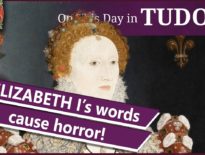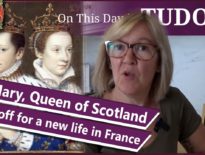On this day in Tudor history, 8th August 1553, fifteen-year-old King Edward VI was buried in Henry VII’s Lady Chapel in Westminster Abbey in a funeral service performed by Thomas Cranmer, Archbishop of Canterbury.
Although his Catholic half-sister, Mary, was on the throne, Edward was buried with Protestant rites and it was the first time the English Book of Common Prayer was used for the funeral of a monarch.
Find out more about Edward VI's funeral, how Mary I marked his passing, and Edward VI's resting place, in today's talk.
Also on this day in Tudor history, 8th August 1588, Queen Elizabeth I decided to accept Robert Dudley, Earl of Leicester's invitation to visit the troops he had gathered near Tilbury Fort to guard the eastern approach to London against the expected invasion by the Spanish Armada. Why did Leicester invite the queen to Tilbury? Find out in last year’s video:
Also on this day in history:
- 1503 – The formal wedding of Margaret Tudor and James IV of Scotland in the chapel of Holyroodhouse. The couple had been married by proxy on 15th January 1503 with Patrick Hepburn, the Earl of Bothwell and Lord High Admiral of Scotland, standing in for James. Bothwell was the great-grandfather of James Hepburn, 4th Earl of Bothwell, husband of Mary, Queen of Scots.
- 1558 – Birth of George Clifford, 3rd Earl of Cumberland, courtier and privateer, at Brougham Castle, Westmorland. Elizabeth I nicknamed Cumberland her “rogue”, and he was her Champion from 1590 until her death.
- 1560 – Death of William May, Archbishop-elect of York, in London. He died on the day that he was elected Archbishop.
- 1570 – Execution of John Felton, Roman Catholic martyr, at St Paul's Churchyard. He was hanged, drawn and quartered.
- 1573 – Death of Simon Renard, Imperial Ambassador, in Madrid, Spain.
- 1586 or 1587 – Execution of John Finglow, Roman Catholic priest and martyr, at York. He also was hanged, drawn and quartered.
Transcript:
On this day in Tudor history, 8th August 1553, fifteen-year-old King Edward VI was buried in a white marble vault beneath the altar of Henry VII’s Lady Chapel in Westminster Abbey. Edward had died on 6th July 1553 but the struggle for the throne, between the heir he had appointed, Lady Jane Grey, and his half-sister, Mary, plus discussions between Mary I and her ministers over his funeral rites, had led to a delay in burial. It was finally decided that Edward would be buried with Protestant rites, the first use of the English Book of Common Prayer for the funeral of a monarch, and it was Thomas Cranmer, Archbishop of Canterbury, who performed the service.
Merchant-taylor Henry Machyn recorded the funeral procession in his diary:
“The 8th day of August was buried the noble king Edward the vi, and 7th year of his reign; and at his burying was the greatest moan made for him of his death as ever was heard or seen, both of all sorts of people, weeping and lamenting; and first of all went a great company of children in their surplices, and clerks singing; and then his father’s bedmen, and then 2 heralds and then a standard with a dragon, and then a great number of his servants in black, and then another standard with a white greyhound, and then after a great number of his officers and after them came more heralds, and then a standard with the head officers of his house; and then heralds, Norroy bore the helmet and the crest on horseback, and then his great banner of arms embroidered, and with diverse other banners, and then came riding master Clarenceux with his target, with his garter, and his sword, gorgeously and rich, and after Garter with his coat armour embroidered, and then more heralds of arms; and then came the chariot with great horses trapped with velvet to the ground, and every horse having a man on his back in black, and every one bearing a banner-roll of diverse kings arms, and with escutcheons on their horses, and then the chariot covered with cloth of gold, and on the chariot lay on a picture lying richly with a crown of gold, and a great collar, and his sceptre in his hand, lying in his robes and the garter about his leg, and a coat in embroidery of gold; about the corpse were borne four banners, a banner of the order, another of the red rose, another of queen Jane (Seymour), another of the queen’s mother. After him went a goodly horse, covered with cloth of gold unto the ground, and the master of the horse, with a man of arms in armour, which was offered, both the man and the horse. There was set up a goodly hearse in Westminster abbey with banner rolls and pensells, and hung with velvet about.”
Edward’s half-sister, the Catholic Queen Mary I, did not attend and, instead, had requiem masses sung at the Tower of London for three days beginning on 8th August at Vespers.
Edward’s grave was unmarked until 1966 but his coffin was seen in the 19th century and it was labelled with a Latin inscription which, when translated, read:
“Edward the sixth by the Grace of God King of England, France and Ireland, Defender of the Faith and on earth under Christ supreme head of the churches of England and Ireland and he migrated from this life on the 6th day of July in the evening at the 8th hour in the year of our Lord 1553 and in the 7th year of his reign and in the 16th year of his age.”
In 1966, a stone was placed in front of the altar of the chapel, marking his burial site and inscribed with the following memorial:
“IN MEMORY OF KING EDWARD VI BURIED IN THIS CHAPEL THIS STONE WAS PLACED HERE BY CHRIST’S HOSPITAL IN THANKSGIVING FOR THEIR FOUNDER 7 OCTOBER 1966.”



Leave a Reply